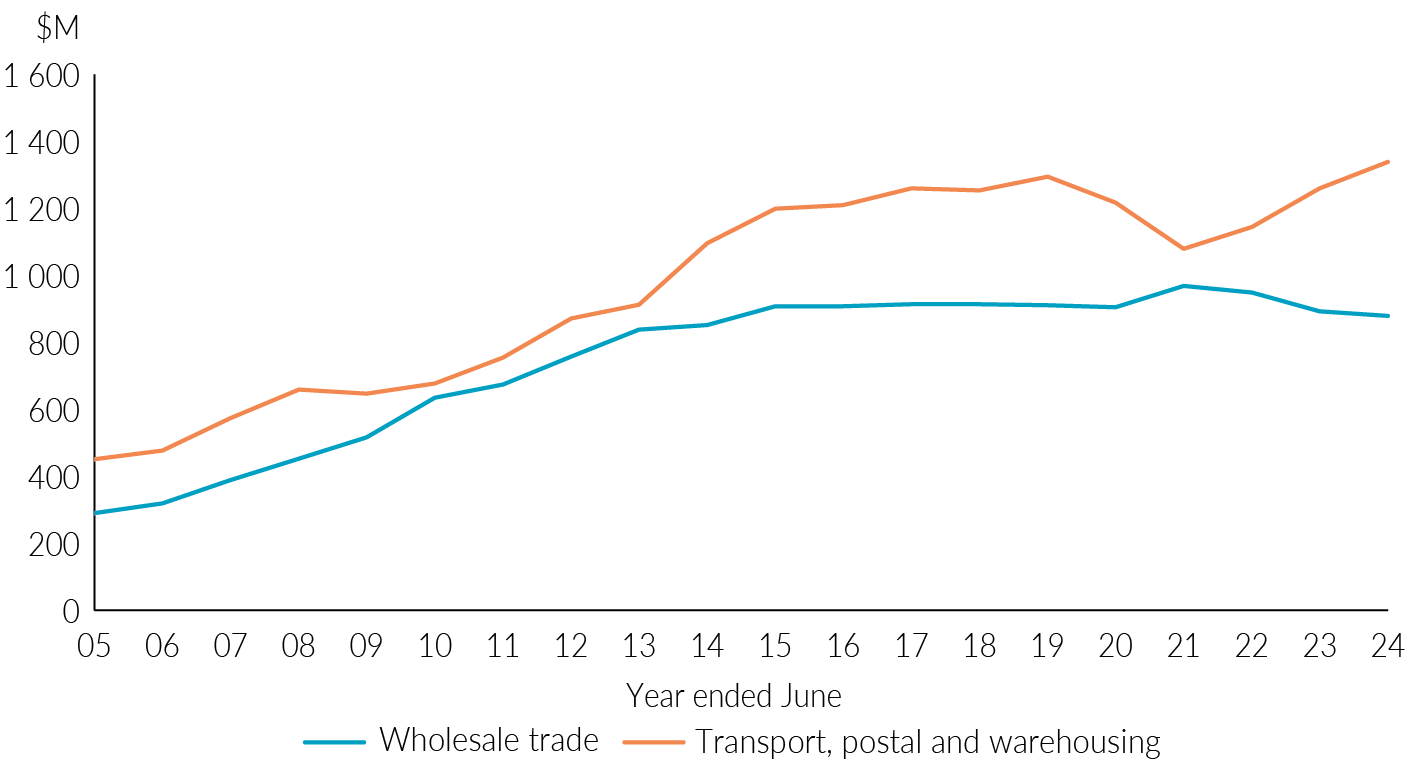Retail and wholesale trade
Outlook
Growth in the retail trade industry is expected to be modest in 2024-25. While household consumption growth has been solid, this is largely due to spending on services rather than retail goods. Wholesale trade is expected to be supported in 2024-25 by strong investment activity. The wholesale trade industry supports investment by facilitating the supply of specialist equipment and materials.
In 2023-24, the Territory retail and wholesale trade sector contributed $1.8 billion to the Territory’s economy, a similar value to 2022-23, and its share of GSP increased from 5.5% to 5.7% in 2023‑24. The sector’s contribution to GSP is relatively low compared with other jurisdictions, reflecting the dominance of government and community services, and mining sectors in the Territory economy.
In the short term, the retail and wholesale trade sector will be supported by a solid outlook for household consumption. The wholesale trade industry will face weaker demand from declining levels of investment from 2025-26 as work on Barossa is completed.
Retail trade
Retail trade’s contribution to GSP increased by 0.6% to $930 million in 2023-24. This is slightly higher than the 0.2% growth in real retail turnover in 2023-24, possibly reflecting retailers taking the opportunity to rebuild margins following several years of high inflation (Chart 11).
Chart 11: Retail sales in the Territory (quarterly, seasonally adjusted, chain volume measure)
Source: ABS, Retail Trade, Australia
Over 2025, household consumption is expected to increase, supporting the retail sector, with a rise in real disposable income due to stage 3 tax cuts, real wage growth, and further anticipated cuts to the cash rate.
Several public and private developments are expected to support retail investment and turnover in the near term, including the Civic and State Square revitalisation and Northern Territory Art Gallery.
Sentinel Property Group plans to improve the layout and security at Casuarina Shopping Centre by building a new three-storey carpark, reconfiguring the Trower Road entrance and creating new tenancies at the ground level. The project is targeting construction commencement in the second half of 2025.
Online sales in the Territory grew by 11.3% in 2024 according to the Australia Post e-commerce update. Since its surge during covid, online shopping has firmly established itself as an integral part of consumer behaviour and local retailers will need to compete more with other suppliers interstate and overseas. Online retailing expenditure is only partially captured in ABS data, as it only reflects online retail sales by Australian retailers. E-commerce shops can be in other jurisdictions or overseas, meaning growth in online retail expenditure does not necessarily translate to growth in the retail industry in the Territory.
Wholesale trade
In 2023-24 the wholesale trade industry’s contribution to GSP declined by 1.6% to $878 million in the Territory, compared to a 3.3% decline nationally.
Wholesale trade broadly tracks activity in other sectors, including retail trade that relies on wholesalers for the supply of goods, and capital-intensive industries like mining and manufacturing that depend on wholesalers for large quantities of material, machinery and equipment. This trend is also evident in the transport, postal and warehousing industry (Chart 12).
Chart 12: Support industries gross value added
Source: ABS, Australian National Accounts: State Accounts
Infrastructure investment can provide significant support to the wholesale sector. Projects that will facilitate future growth in the wholesale trade industry include various road upgrades (which will support movement of freight), industrial land releases in Berrimah North, and the development of the Marine Industry Park.
For the latest data on the retail and wholesale trade sector, refer to the Territory Economy website.


